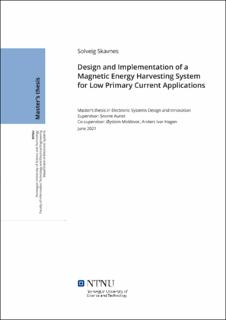| dc.contributor.advisor | Aunet, Snorre | |
| dc.contributor.advisor | Hagen, Anders Ivar | |
| dc.contributor.advisor | Moldsvor, Øystein | |
| dc.contributor.author | Skavnes, Solveig | |
| dc.date.accessioned | 2021-12-16T18:19:56Z | |
| dc.date.available | 2021-12-16T18:19:56Z | |
| dc.date.issued | 2021 | |
| dc.identifier | no.ntnu:inspera:77039769:55679418 | |
| dc.identifier.uri | https://hdl.handle.net/11250/2834792 | |
| dc.description.abstract | Energihausting er å utnytte små mengder omkringliggjande energi for å drive eit lavenergisystem, slik som for eksempel ei sensornode. Dette kan gjerast frå magnetfelta som kjem frå ein vekselstraum, Ip, som går gjennom ei leidning. Målet med masteroppgåva er å utvikle eit system som klarer å levere 3,3 V ut for å lade eit batteri, mens Ip er under 1 A. Systemet burde fungere for Ip-ar under 1 A, sidan dette mogleggjer at systemet kan lade eit batteri mykje av tida, sjølv om det ikkje går høge vekselstraumar gjennom leidninga. Eit magnetisk energihaustingssystem kan bestå av ein straumtransformator (engelsk: Current Transformer) eller CT, ein likerettar og ein DC/DC-omformar. Eit slikt system er designa, simulert ved bruk av SPICE og implementert ved å bruke komponentar på eit breadboard. Dei ulike undersystema er testa individuelt og saman. Fem ulike CTar er testa. Tre ulike likerettarar er designa og testa, og to ulike DC/DC-omformarar er testa. Dette blir totalt 30 undersystemkonfigurasjonar, kor tre av dei oppfyller kravet om å fungere ved Ip < 1 A. Den kombinasjonen av undersystem som klarar å levere 3,3 V ut med den lavaste Ip inn er kombinasjonen av ein CT med 1:2000 vindingsforhold, ein likerettar basert på schottkydioder og ein DC/DC-omformar som har ein høg inngangsmotstand. Dette systemet leverer 3,3 V ut ved Ip = 0,5 A. Dei tre undersystemkonfigurasjonane som oppfyller kravet er alle saman testa og verifisert at dei fungerer opp til Ip = 16 A. Eit kommersielt energihaustingssystem med kombinert likerettar og DC/DC-omformar er testa som ei samanlikning, med dei same fem CTane testa tidlegare. Dette systemet er LTC3331 og saman med ein CT med 1:2000 viklingsforhold treng dette systemet Ip = 5 A for å levere 3,3 V ut, noko som er signifikant dårlegare enn det beste systemet som er designa og testa i denne masteroppgåva. | |
| dc.description.abstract | Energy harvesting is the act of exploiting small amounts of ambient energy to power a low power system, like a sensor node. This can be done from the magnetic fields originating from an AC current, Ip, flowing through a power cable. The aim of this thesis is a system that is able to deliver 3.3 V to charge a battery, while Ip is under 1 A. The system should work for Ips under 1 A, since this will allow it to charge a battery a lot of the time even if the cable it is connected to is not carrying high AC currents. A magnetic energy harvesting system can consist of a current transformer (CT), a rectifier and a DC/DC converter. Such a system is designed, simulated using SPICE and implemented using components on a breadboard. The different sub-systems are tested individually and together. Five different commercial CTs are tested. Three different rectifiers are designed and tested, and two DC/DC converters are tested. This makes a total of 30 sub-system configurations, of which three fulfil the requirement of working at Ip < 1 A. The combination of sub-systems that manages to deliver 3.3 V to a battery on the lowest Ip is the combination of a CT with a 1:2000 turn ratio, a schottky diode rectifier and a high input resistance DC/DC converter. This system delivers 3.3 V to an attached battery at Ip = 0.5 A. It is tested and verified that the three sub-system configurations that work at Ip < 1 A continue to work up to Ip = 16 A. A commercial energy harvesting system with a combined rectifier and DC/DC is tested with the five CTs under the same conditions as a comparison. This is the LTC3331, and together with the best performing CT, it requires Ip = 5 A to deliver 3.3 V to a battery, making the commercial solution significantly worse than the system designed in this thesis. | |
| dc.language | eng | |
| dc.publisher | NTNU | |
| dc.title | Design and Implementation of a Magnetic Energy Harvesting System for Low Primary Current Applications | |
| dc.type | Master thesis | |
